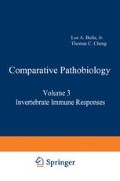Abstract
Haeckel (1862) was the pioneer in reporting that the hemolymph cells of molluscs are capable of phagocytosis. Since that initial report, a number of individuals have demonstrated the phagocytosis of nonself materials by molluscan cells (see Feng, 1967; Cheng, 1967; for reviews).
Access this chapter
Tax calculation will be finalised at checkout
Purchases are for personal use only
Preview
Unable to display preview. Download preview PDF.
References
Arcadi, J. A. (1968). Tissue response to the injection of charcoal into the pulmonate gastropod Lehmania poirieri. J. Invertebr. Pathol., 11, 59–62.
Bayne, C. J. (1973). Molluscan internal defense mechanism: the fate of 14C-labeled bacteria in the land snail Helix pomatia (L.). J. Comp. Physiol., 86, 17–25.
Bayne, C. J. and Kime, J. B. (1970). In vivo removal of bacteria from the hemolymph of land snail Helix pomatia (Pulmonata: Stylommatophora). Malacol. Rev., 3, 103–113.
Cheng, T. C. (1967). Marine molluscs as hosts for symbioses. Adv. Mar. Biol., 5, 1–424.
Cheng, T. C. (1975). Functional morphology and biochemistry of molluscan phagocytes. Arm. N.Y. Acad. Sci., 266, 343–379.
Cheng, T. C. and Cali, A.(1974). An electron microscope study of the fate of bacteria phagocytized by granulocytes of Crassostrea virginica. Contemp. Top. Immunobiol., 4, 25–35.
Cheng, T. C. and Rifkin, E.(1970). Cellular reactions in marine molluscs in response to helminth parasitism. In “Diseases of Fish and Shellfish.” Am. Fisher. Soc. Spec. Publ. No. 5. Washington, D. C.
Cheng, T. C., Thakur, A. S., and Rifkin, E.(1969). Phagocytosis as an internal defense mechanism in the Mollusca: with an experimental study of the role of leucocytes in the removal of ink particles in Littorina soabra Linn. Proc. Symp. Mollusca, Part II, 546–563, Marine Biol. Assoc. India.
Cheng, T. C., Cali, A., and Foley, D. A. (1974). Cellular reaction in marine pelecypods as a factor influencing endosymbioses. In “Symbiosis in the Sea.” (W. B. Vernberg, ed.). Univ. South Carolina Press, Columbia S.C. pp. 61–91.
Des Voigne, D. M. and Sparks, A. K.(1968). The process of wound healing in the Pacific oyster, Crassostrea gigas. J. Invertebr. Pathol., 12, 53–65.
Feng, S. Y. (1959). Defense mechanism of the oyster. Bull. N.J. Acad. Sci., 4, 17.
Feng, S. Y. (l965). Pinocytosis of proteins by oyster leucocytes. Biol. Bull., 128, 95–105.
Feng, S. Y.(1967). Responses of molluscs to foreign bodies, with special reference to the oyster. Fed. Proc., 26, 1685–1692.
Haeckel, E. (1862). Die Radiolarien. Geo. Reimer, Berlin.
Pauley, G. B. and Heaton, L. H.(1969). Experimental wound repair in the fresh-water mussel Anodonta oregonensis. J. Invertebr. Pathol., 13, 241–249.
Pauley, G. B. and Krassner, S. M. (1972). Cellular defense reactions to particulate materials in the California sea hare, Aplysia californioa. J. Invertebr. Pathol., 19, 18–27.
Pauley, G. B. and Sparks, A. K. (1965). Preliminary observations on the acute inflammatory response in the Pacific oyster, Crassostrea gigas (Thurnberg). J. Invertebr. Pathol., 7, 248–256.
Polglase, W. J., Smith, E. L., and Tyler, R. H. (1952). Studies on human glycogen I. Preparation, purity, and average chain length. J. Biol. Chem., 199, 97–104.
Reade, P. C. (1968). Phagocytosis in invertebrates. Aust. J. Exp. Biol. Med. Sci., 46, 219–229.
Scott, R. M.(1969). Clinical analysis by TLC. Ann Arbor-Humphrey Science Publ. Ann Arbor, Michigan.
Sminia, T.(1972). Structure and function of blood and connective tissue cells of the fresh water pulmonate Lymnaea stagnalis studied by electron microscopy and enzyme histochemistry. Z. Zellforsch., 130, 497–526.
Stauber, L. A. (1950). The fate of India ink injected intracardially in the oyster, Ostrea virginica Gmelin. Biol. Bull., 98, 227–251.
Staurt, A. E.(1968). The reticuloendothelial apparatus of the lesser octopus, Eledone cirrosa. J. Path. Bact., 96, 401–412.
Takatsuki, S. (1934). On the nature and function of the amoebocytes of O. edulis. Quart. J. Miorosc. Sci., 76, 379–431.
Tripp, M. R. (1958a). Disposal by the oyster of intracardially injected red blood cells of vertebrates. Proc. Nat. Shellfish. Assoc., 48, 143–147.
Tripp, M. R. (1958b). Studies on the defense mechanism of the oyster. J. Parasitol., 44(Sect. 2), 35–36.
Wagge, L. E. (1951). The activity of amoebocytes and of alkaline phosphatases during the regeneration of shell of the snail Helix aspersa. Quart. J. Microsc. Sci., 92, 307–321.
Wagge, L. E.(1955). Amoebocytes. Int. Rev. Cytol., 4, 31–78.
Yonge, C. M. (1923). The mechanism of feeding, assimilation, and digestion in Mya arenaria. Brit. J. Exp. Biol., 1, 15–63.
Yonge, C. M. (1926). Structure and physiology of the organs of feeding and digestion in Ostrea edulis. J. Mar. Biol. Assoc. U.K., 14, 295–388.
Yonge, C. M. and Nicholas, H. M. (1940). Structure and function of the gut and symbiosis with zooxanthellae in Tridaona crispata (Oerst). Bgk. Papers Tortugas Lab. Carnegie Inst., 32, 287–301.
Zacks, S. I.(1955). The cytochemistry of the amoebocytes and intestinal epithelium of Venus mercenaria (Lamelli branchiata), with remarks on a pigment resembling ceroid. Quart. J. Microsc. Sci., 96, 57–71.
Zacks, S. I. and Welsh, J. H.(1953). Cholinesterase and lipase in the amoebocytes, intestinal epithelium and heart muscle of the quahog, Venus mercenaria. Biol. Bull., 105, 200–211.
Author information
Authors and Affiliations
Editor information
Editors and Affiliations
Rights and permissions
Copyright information
© 1977 Plenum Press, New York
About this chapter
Cite this chapter
Cheng, T.C. (1977). Biochemical and Ultrastructural Evidence for the Double Role of Phagocytosis in Molluscs: Defense and Nutrition. In: Bulla, L.A., Cheng, T.C. (eds) Comparative Pathobiology. Comparative Pathobiology, vol 3. Springer, Boston, MA. https://doi.org/10.1007/978-1-4615-7299-2_2
Download citation
DOI: https://doi.org/10.1007/978-1-4615-7299-2_2
Publisher Name: Springer, Boston, MA
Print ISBN: 978-1-4615-7301-2
Online ISBN: 978-1-4615-7299-2
eBook Packages: Springer Book Archive

